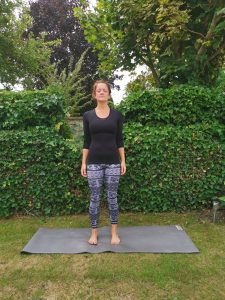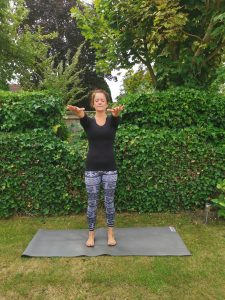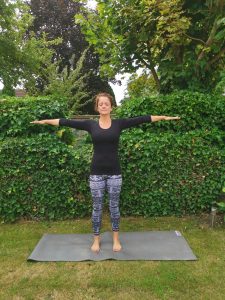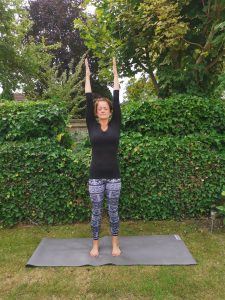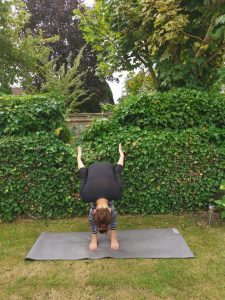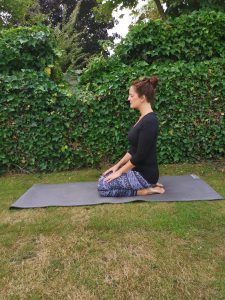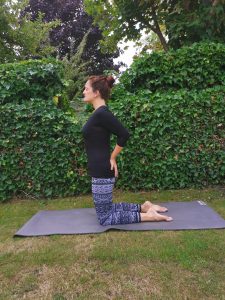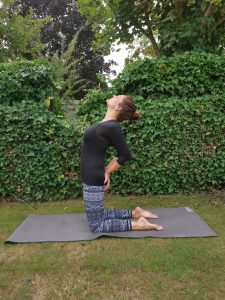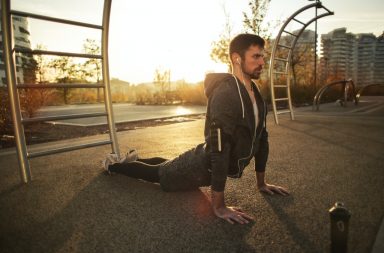Yoga: The great and powerful (healthy) opiate of the masses. There are many types of yoga to choose from, but they all stem from one main focus: to increase strength and resilience whilst reducing stress. One incredible way to reduce stress is by boosting serotonin levels. Serotonin is a neurotransmitter — a chemical that sends messages around the body. It is also a great mood stabiliser. And we have the 5 yoga poses to increase serotonin levels, right here. Whether you are into regular workouts or have mobility issues: we have something for you!
Yoga has become a permanent fixture of the western world over the past few decades. But it hasn’t always been this way. Brought to the Western world by Russian-born pioneering female yogi Indra Devi (Eugenie Peterson) at the end of the 1940s, it became the jewel of the higher classes. A way to exercise and maximise wellness, inside and out. Today, yoga has many fans: from the sportswear toting ‘yummy mummy’ to Brazilian Jujitsu practitioners, and everyone between.
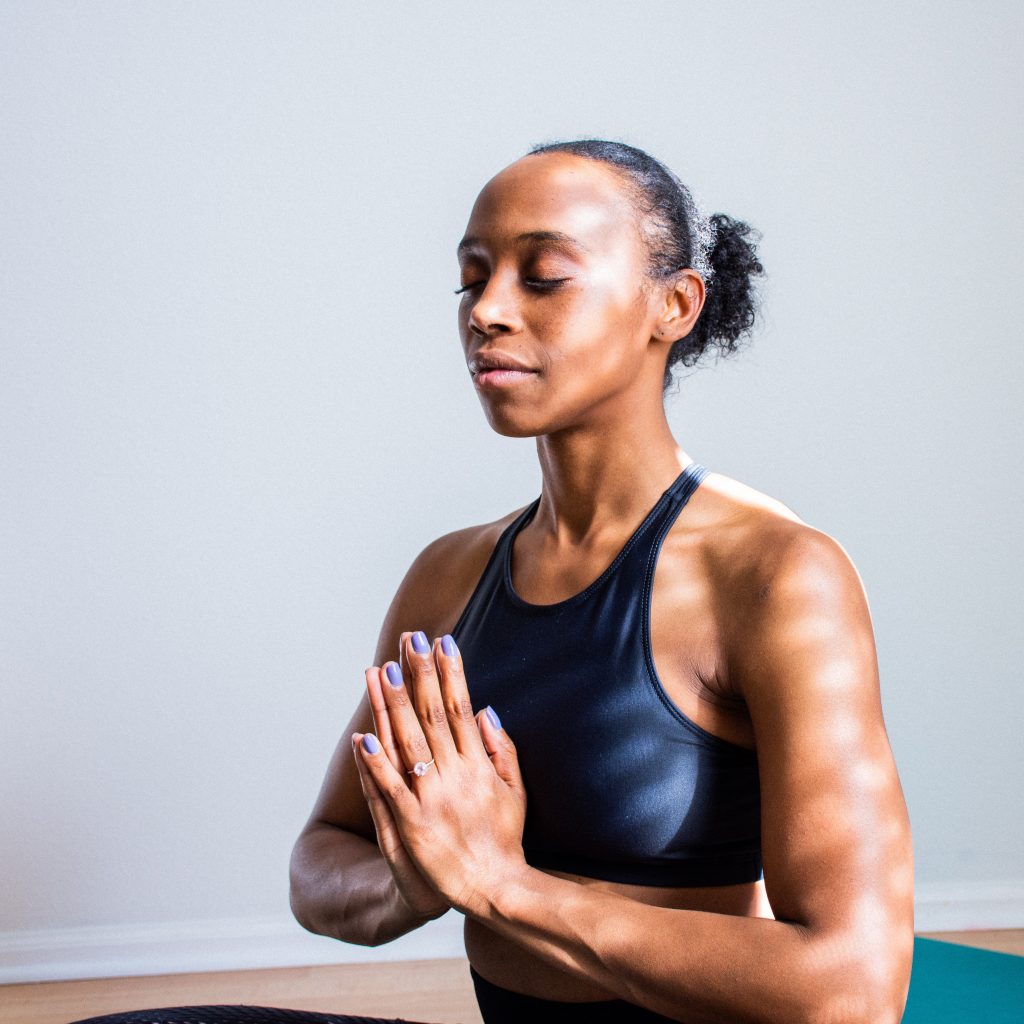
Photo by madison lavern on Unsplash
As there are many different types of yoga, our top 5 poses encompass the core tenets of yoga from various practices: Asana (yogic poses) and breath-work. Breathing is so automatic for us that we take it for granted. But so few of us actually utilise the full capacity of our lungs. Rarely, then, do we get optimum oxygen levels in our blood. These poses will help to open up the lungs and energetic channels, drawing clean energy in whilst boosting the production of good chemicals within the body.
There is so much to know, and even the smallest moves that can create big results. Read on for more yoga knowledge. But first, more about those mood-boosting chemicals!
What Does Serotonin do?

Photo By erikreis
Serotonin is known as a neurotransmitter: it carries signals between cells and nerves throughout the body. The main responsibility is to regulate the speed and capability of the internal organs. It does this by carrying messages that ensure their functions are properly carried out.
The same function is provided within the brain. Messages pass through the brain, carrying information and inducing action.
Put simply, serotonin is a mood regulator within the mind. The better the production of this chemical, the higher the capacity for storing and using information. But also, the ability to actively (rather than passively) cope with new situations. When including yoga poses that help to increase serotonin levels into your daily routine, your ability to rise above problems increases. You gain clarity. Studies have shown that greater serotonin production influences subjects’ ability to handle stress through increased levels of patience and tolerance. People with high levels of serotonin are able to approach situations with a more open mind, creating better coping strategies.
This works in tandem with dopamine, which is known as our body’s reward chemical. Both are known as monoamines, but perform different tasks. Dopamine increases the likelihood of reaching for that third donut. Or the tendency to not complete work assignments on time. The presence of serotonin, however, overrides impulsive desires, allowing us to think more logically about future outcomes. In doing so, better long-term choices are made.
15 Foods High in GBA and Serotonin: Soy Nuts & Oolong Tea
Where is Serotonin Created?
Serotonin is produced naturally within the body. It is present within the intestines, but can also be found amidst the blood platelets within the central nervous system (CNS). The brain creates serotonin too—a necessary function as it cannot be passed via the blood into the brain. If it didn’t create serotonin, our brains would go without. Which would be a disaster.
All the more reason to have a selection of serotonin-boosting exercises in your repertoire!
Could just 5 yoga poses increase serotonin levels in the body and brain? Yes, and this could benefit mood as well as the healthy functioning of our internal organs and CNS.
How do I Know if my Serotonin Levels Are Low?

Photo by Nik Shuliahin on Unsplash
As serotonin is especially useful for aiding digestive function and as a mood stabiliser, a number of issues could present themselves in these areas.
Those low in serotonin within the brain could experience various symptoms: difficulty in making decisions, depression, and anxiety. Even impulsive, antagonistic or even aggressive behaviour. Within the digestive system, symptoms can range from nausea and loss of appetite to IBS (irritable bowel syndrome), weight gain or cravings for high-carb foods.
Low serotonin has also been linked to several psychological issues: eating disorders, panic attacks and social anxiety. General fatigue and nervous behaviours are also common.
What Are the Benefits of Yoga Poses? How do they Increase Serotonin?
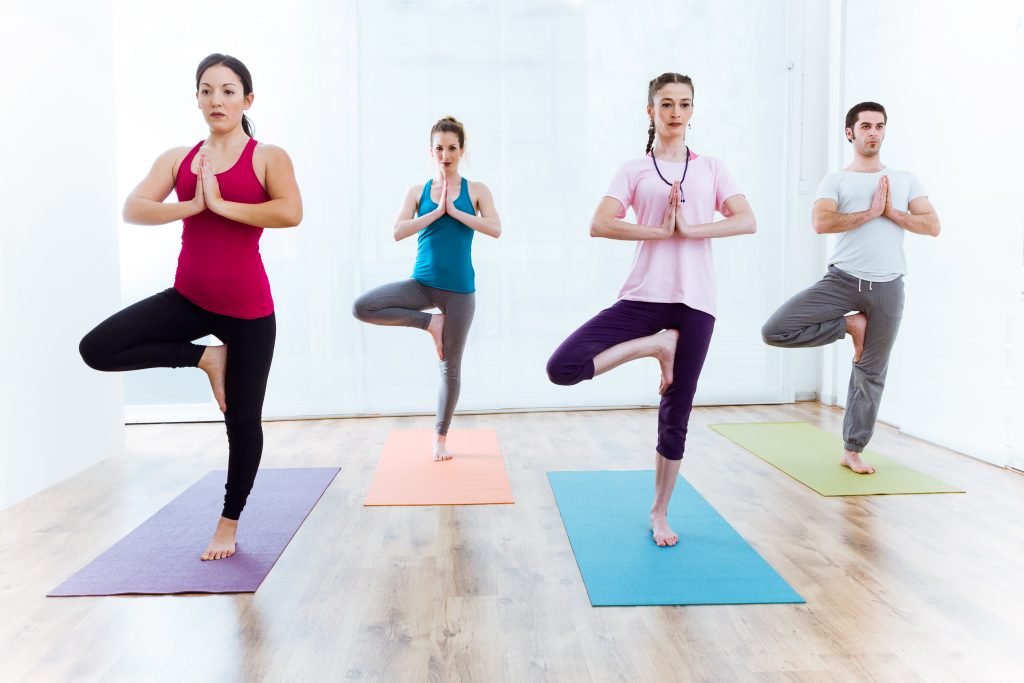
Vrksasana pose
Yoga is a very interesting practice. Whilst most other forms of exercise focus on the body, all forms of yoga have a holistic approach to health. That is, how the body and mind connect and become stronger and more resilient. Additionally, yogic exercises are based around the power and flexibility of your own body. It doesn’t matter how deep you get into a pose, so long as you feel a stretch and its benefits.
Disadvantages of Ayurvedic Medicine: Is the Ancient Treatment Safe?
All forms of Yoga are based on the Ayurvedic principles. Meaning the body’s ability to heal itself naturally, and with holistic remedies, healthy diet and movement. As you are performing these poses, you will find your natural flexibility improving. Not only that, poses such as twists and backbends serve to massage the internal organs, which promotes better blood flow. This will also increase the movement of bodily liquids and chemicals. This in turn boosts and stimulates the flow of serotonin to the organs and within the brain, which is just one of the many ways yoga helps increase serotonin levels.
And the most nourishing thing of all: yoga promotes a sense of wellness within each person, as you learn to trust your body and let go of stress and discomfort. As confidence increases within the practice, it ripples out into everyday life. A greater sense of peace and capability manifests within.
Yes, yoga truly is for all levels of ability. Indeed, many yoga instructors inform patrons at the beginning of a class: “even if you were to sit with crossed legs, or lay on the floor and breathe deeply for the entire session, you would still be doing yoga.”
How Can Breathing Boost Yoga Poses to increase Serotonin?
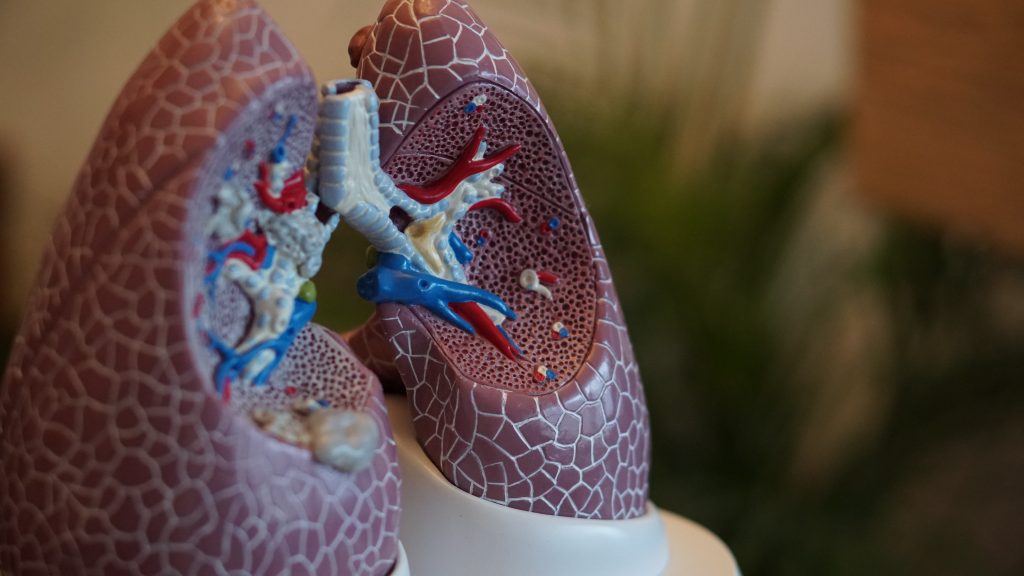
Photo by Robina Weermeijer on Unsplash
The root of yoga is in how you breathe. There are many different forms of breathing in yoga, known as the pranayama. Ujayi breathing is most commonly utilised within yoga practice. It heats the body from the inside, stimulating detoxification. To do this, breathe in and out through the nose whilst forming a slight constriction in the back of the throat. It will feel the same as when you fog up a mirror with your breath. A person next to you should be able to hear your breath.
The plain fact is, most of us don’t use our lungs properly. Yet, when we make small changes to our breathing, our blood becomes more oxygenated. This fresh blood flows through the organs, promoting optimal functioning.
The best way to increase your oxygen levels is to start small. Spend five to ten minutes standing or sitting upright in a chair, shoulders back. Inhale deeply for five seconds, filling the lungs. Hold while counting to five, exhale for five, then repeat. Continue this exercise daily and you will find your breathing cycle naturally extends as you use greater lung capacity.
There are many other breath practices. And working on this will pay dividends for energy levels if you commit. It could increase strength, speed and recovery time when exercising, and even improve flexibility in the long run.
How can I become More Flexible in Yoga?
Yoga is such a personal thing — this is why so many yogic traditions exist. As long as you feel a stretch and observe good alignment, you are doing it right. It’s not about showing off, but increasing your health: mentally, physically and spiritually. Even if you are just in it for the physical fitness.
Having said that, the American community ‘Doctors of Osteopathic Medicine’ also speak of the benefits of yoga. Yoga can be used to increase flexibility, and as a prevention and a cure for a variety of medical issues. Their holistic approach, as noted on their website, states:
“purpose of yoga is to build strength, awareness and harmony in both the mind and body,” [osteopathic.org].
With greater flexibility, you gain confidence in your ability to move. Naturally, you move more. This confidence gives a natural boost to endorphins, which then stimulates the production of other good chemicals such as serotonin.
And if you still require a little flexibility push, you can try these effective exercises at home!
How to Loosen Tight Hamstrings in 3 Surprisingly Simple Steps
Yoga Poses: Increased Serotonin Levels for Mindfulness
One of the ways in which yoga boosts the mood is through mindfulness. When you are engaged with the asana (postures) and breath, your focus is in the present. Worries, fears or regrets tend to fade away. Continuing the practice creates an ease with the asana, and finding this frame of mind becomes fluid as you engage with the moment. This helps to alleviate depression while creating space and mental clarity. This has the same effect as when there are optimal levels of serotonin in the brain. Focus and mental acuity increase, which boosts our ability to make better choices.
Links between low serotonin levels and depression have been studied. It is not clear, however, if a dip in serotonin causes depression, or vice versa. Either way, it is understood that yoga has been known to boost mood and create a sense of wellbeing.
And if these 5 yoga poses increase serotonin levels, so much the better!
By stimulating the parasympathetic nervous system, yoga calms the body and stimulates the production of chemicals such as dopamine, serotonin and oxytocin. Another amazing factor is that serotonin is a front-runner to melatonin. Melatonin is a natural chemical created by the body to help us sleep. As serotonin can be converted into melatonin, higher production of this means more of the other. And we all know a better night’s sleep does wonders for our mood!
Sleep-inducing foods: 5 of the best
Breath and Asana: 5 Yoga Poses to Increase Serotonin Levels

Photo by Victor Garcia on Unsplash
In Kundalini Yoga, it is said that even sitting in a cross-legged position (known as ‘easy pose’) whilst breathing deeply for 3 minutes can stimulate the production of serotonin and dopamine. Kundalini focuses on breath work, incorporating short bursts of repetitive movement. These movements or ‘kriya’ are intended to activate the internal body including organs, glands and the mind. The goal is generally to stimulate the body’s natural production of healthy chemicals, aiding optimum organ function.
Other Yogic traditions focus on the breath with more intense posture sequences. Either flowing movement (Vinyasa), or in sequences utilising more static poses (Hatha and Ashtanga). These intense postures are often held for longer periods.
Our top 5 yoga poses to increase serotonin levels include a little bit of everything. Flowing movement, static calming postures, and more dynamic and intense options. All designed to stimulate the body whilst activating the PNS (parasympathetic nervous system).
Breath of Joy
- Begin standing upright, knees slightly bent with the palms at the side.
- Inhale one-third of the lungs’ capacity whilst lifting the arms to shoulder height in front of your face, with palms face upward.
- Inhale to two-thirds and bring the arms out to the side, maintaining shoulder height.
- Inhale fully and lift the arms above the head, parallel with palms facing each other.
- Exhale through the mouth loudly as you drop the arms, sending them back behind you with palms facing each other. Knees bend into a high chair position. You may hold this position for 2 breaths or inhale to stand.
- Repeat 9 times (or less), without forcing the position or breath.
The essence of the pose is fluid, so must be done with equal parts strength and softness. It is magnificent for stimulating every single one of your bodily organs and their function. It also activates the parasympathetic nervous system, which is very calming. This activity might seem intense, but once you have mastered the sequence, you will be able to bring calmness and presence to the asana.
Legs Up the Wall Pose (Vaparita Karani)
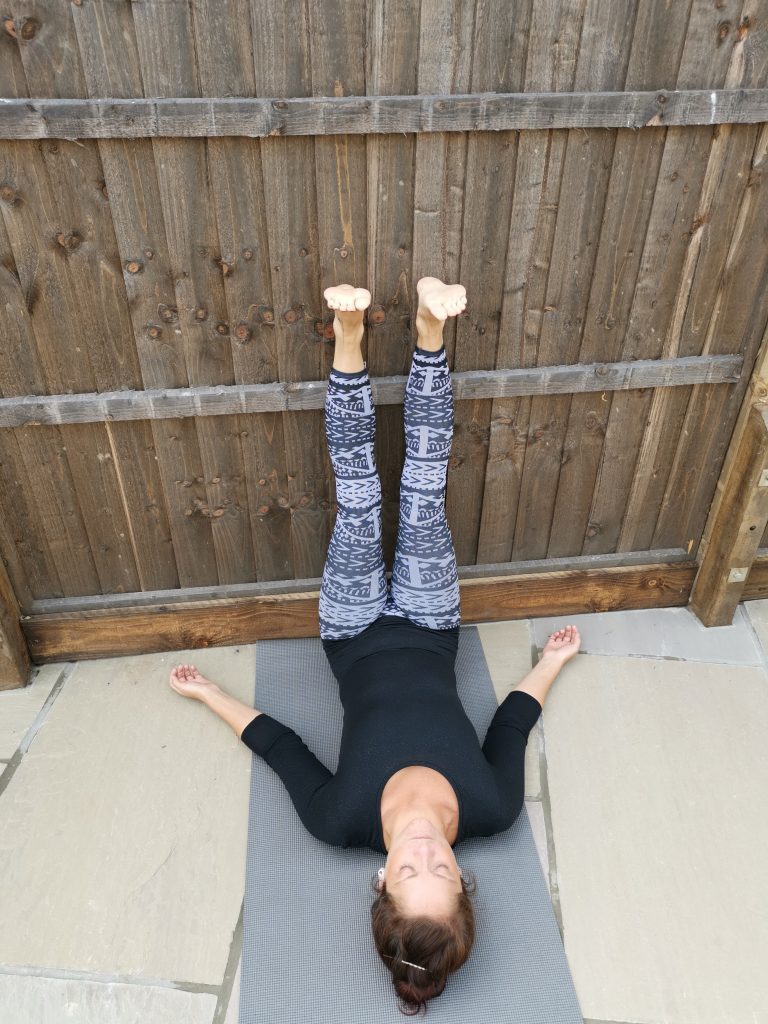
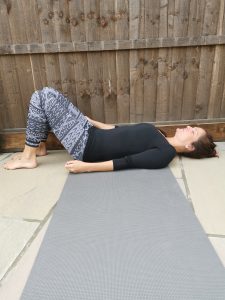
- Begin laying against the wall so one hip is touching.
- Angle the feet toward the ceiling as you shift your bum and hips so that they are touching the wall. Shoulder and hips should be parallel to the wall.
- Rest the calves and heels against the wall. Stay here for 5-10 minutes, breathing deeply through the nose.
As a relaxing pose, this is one that is rarely done; but its benefits are many. It can stimulate relaxation and digestion whilst increasing blood flow to areas that need it. Very rarely do we find our heart lower than our legs, so this position gets more blood pumping to our heart to be sent speeding to other areas.
Camel Pose (Ustrasana)
- Begin kneeling, feet straight back behind with the hands resting on the thighs.
- Inhale and lift up off the knees into an upright position. Place the palms on the sacrum bone, just above the bum muscle, fingertips facing the floor. Shoulders back as you inhale and look up towards the ceiling.
- Lengthen the tailbone towards the floor as your lift up through the chest, bending backwards from the upper middle of your spine.
- Stay here breathing deeply through the nose, bending back incrementally as you exhale. Inhale, lift up to centre, thighs drawing back towards the calves and back to the starting position.
- Repeat this 1-2 times a day for up to 30 seconds. Once you are acclimatised you can build up muscle and spine strength by holding the pose for longer.
Be gentle, and be mindful to not curve into your low spine. Only bend from the upper middle back where the ribcage can protect your spine.
This is a heart-opening pose, and is likely to make your heart race. Be mindful when starting out, but enjoy the energy. This brings fresh blood to the organs, promoting the regulation of much-needed chemicals like serotonin and dopamine. You will feel a greater sense of peace and wellbeing whilst resting afterwards.
Jumping lunges
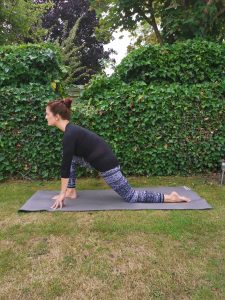
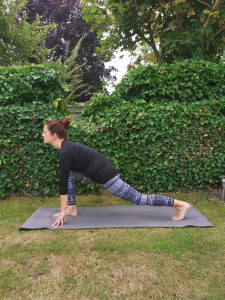
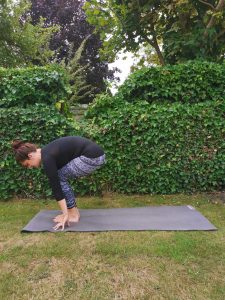
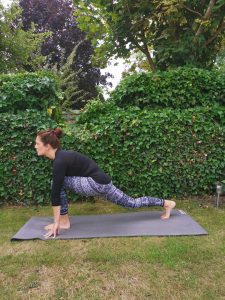
- Begin in a kneeling lunge pose, right foot on the floor with the right knee directly above. Left leg stretches back behind along the floor.
- Fingertips lightly press into the floor as support, shoulders moving back and down towards the hips.
- Inhale and lift the back knee off the floor into runner’s lunge.
- Exhale and step the left leg forward as the right leg moves back.
- Repeat this 10 times breathing deeply in and out through the nose.
Another variation is to hop switch the legs, jumping between positions. This is great for the core, and increases aerobic exertion. Either method will help to increase mobility in your joints, create a stretch, and massage the lower intestine. This promotes better digestive health all-round. And because a lot of serotonin is held within the intestine, stimulating this area will increase chemical production.
Kneeling lunge with Cactus arms

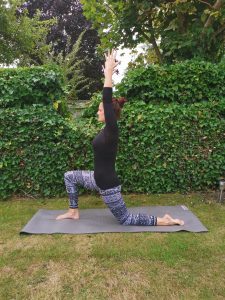
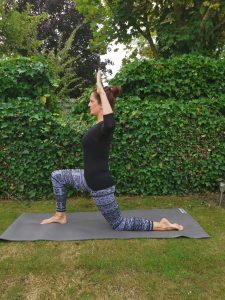
- Begin with the right foot in front, knee directly over as the left leg reaches back behind you. Fingertips are on the floor.
- Lift the torso to a diagonal position, moving out over the bent front knee. Shoulder blades move back and down the body.
- Once stable, inhale as you upright the torso, lifting the arms as the fingertips reach toward the ceiling.
- Exhale and bend the elbows outwards to shoulder height, shoulder blades pressing in toward each other.
- Inhale, lift the arms, exhale, bend the elbows once more.
- Repeat 5-10 times, before switching legs.
Backbends release the shoulders, spine and back muscles. This is something we often neglect. This also stimulates the heart chakra, creating space within the chest — perfect for opening up lungs and increasing oxygen levels! As the heart rate increases, oxygenated blood flows through the body. This stimulates the feel-good chemicals of dopamine and serotonin, boosting those endorphins. You can combine this with jumping lunges for a more aerobic effect.
Aerobic vs anaerobic exercise for fat loss: which is better?
How does Stress Affect Serotonin?
When you feel stress, your body is releasing larger amounts of adrenaline and cortisol into the body. Adrenaline prepares your muscles for the huge amounts of exertion that are needed to outrun or fight a predator. This is known as ‘fight or flight’ mode, a holdover from our prehistoric days.
One function of cortisol is to shut down any unnecessary bodily functions so this energy can be expended in ‘fight or flight’. Functions such as digestion are therefor shut down during periods of stress. It can also disrupt the regulation of blood sugar levels, the metabolism, and the body’s inclination to repair itself. These can have long-term effects on our ability to cope with stress and daily stressors.
As the bulk of serotonin is made within the intestines, stress can have a large effect on its production and function. Production of regulating chemicals is generally interrupted in periods of stress, because energy is conserved for the forthcoming fight or flight. This means that serotonin and dopamine levels can drop, or even spike suddenly after dormant periods. This creates a whole host of issues, including depression, anxiety, weight loss or gain, loss of sex drive and more issues with the internal organs.
Can Stress Cause Gallstones to Flare up?
What Other Activities Produce Serotonin?
One way to increase the production of serotonin is via an amino acid called tryptophan. This chemical is central to the body’s natural creation of serotonin and its sleepier sister melatonin. The good news is you can increase the production of Tryptophan within your diet. This is also beneficial as, whilst serotonin cannot pass through the blood into the brain, tryptophan can. This means eating a healthy diet including foods rich in tryptophan can aid serotonin levels in body and mind.
Tryptophan Rich Vegetarian Foods 15 of the Best out there
Exercise is also a fantastic way to boost endorphins and spur on healthy chemical production. Aerobic exercise has been linked to the creation of cortisone. This is a result of the so-called ‘good stress’ we put ourselves under when exerting the body. Cortisone is the inert (inactive) form of cortisone, which our bodies create when feeling other pressure or stresses. There is evidence to suggest that exerting the muscles stimulates the production of Tryptophan.

Photo by Priscilla Du Preez on Unsplash
Another amazing and underrated way to release endorphins and boost serotonin is hugging! Everyone understands the connecting power of a good long cuddle. What you might not know is how a hug can stimulate and regulate the production of many good bodily chemicals. Committing to a hug for 20 seconds or more stimulates the production of oxytocin, which can lower blood pressure if you have anxiety. It also reduces cortisol and can regulate the production of serotonin and dopamine. This is excellent news as too much of these can also cause negative health issues.
What Does too Much Serotonin Cause?
We already know how the production of dopamine and serotonin are linked. Too much of one and not enough of the other can cause negative effects on our mind and body. Not enough serotonin can cause dopamine to take over, leaving us to act impulsively and perhaps not take good care of our health and wellbeing.
Too much serotonin can have surprising effects on the body. It is worth understanding these in order to monitor your health, and taking steps to lower your body’s serotonin production naturally, if you can.
Symptoms of overproduction can range from mild—confusion, headaches, profuse sweating and aching muscles—to more intense, such as fever, high or unusual heart rate, even seizures.
There are ways to naturally reduce serotonin levels. Drinking small amounts of caffeine, eating cooked whole foods that are low in fibre. A good rule of thumb is to eat foods that are easy to digest, so less mean and more veggies and fruits. Overstimulation of the brain is also a no-go, so shut off the TV and read a book, do a crossword or some Sudoku. This will serve to tire out your brain, which lowers the production of chemicals and can help to induce sleep.
Serotonin Matters: Mind, Body & Soul
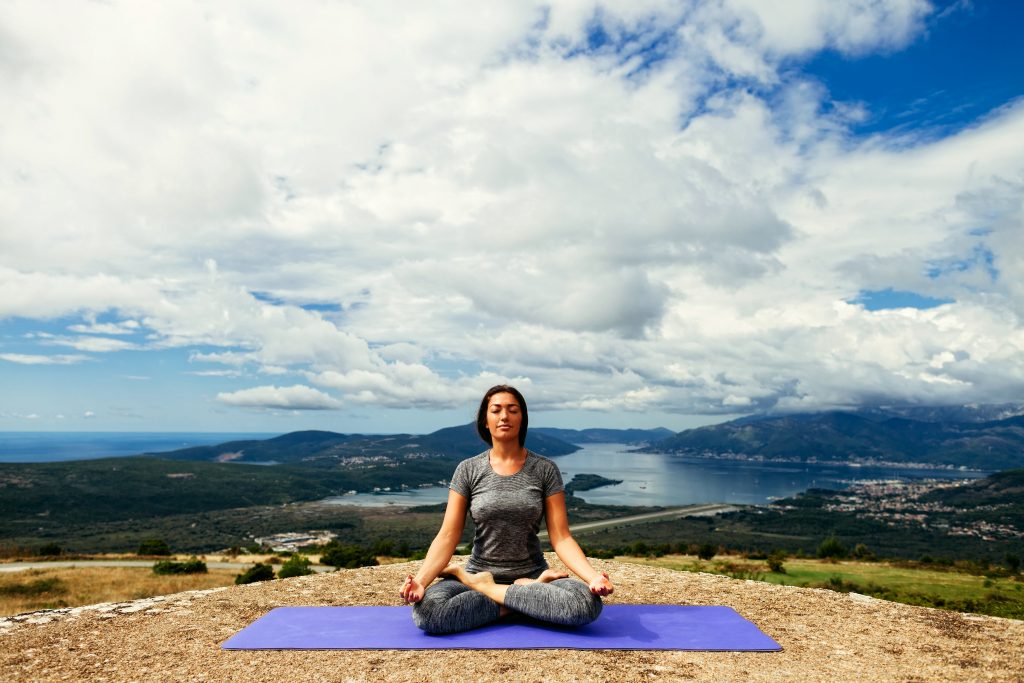
Photo by avanti_photo
There can be no doubt that our bodies are the ‘Goldilocks-verse’. Too much or too little of anything we need can cause inverse effects and sub-optimal health. Serotonin is no different. And whilst we need to look after the natural production of all our chemicals, the way serotonin permeates the body and mind to aid its natural function means it is incredible. So it is definitely one we must take more care of.
Whilst links have been drawn between serotonin levels and depression, the exact interaction is yet to be identified. However, the link between yoga and increased levels of mental health and overall wellbeing cannot be undermined. Yoga as an exercise is incredibly beneficial, allowing people of all ages and flexibilities to work at their own pace and boost their health. Yoga as a spiritual practice can serve to combat depression and anxiety as it draws your focus inward, allowing mental space and clarity. As an holistic practice, Yoga drives increased confidence by creating small gentle changes within the mind and body that spur optimal health.
Breathing and asanas (poses) massage the muscles and internal organs, stimulating the production of those beneficial chemicals. And serotonin could even be thought of as the ‘king chemical’, sending messages throughout the body and mind, creating more intent behind our thoughts, moods and movements.
Including these 5 yoga poses in a short, daily practice regime will definitely increase your serotonin levels. With increased serotonin, the world can feel a more peaceful and more comfortable place. And, sometimes, we all need a little more peace and comfort!
